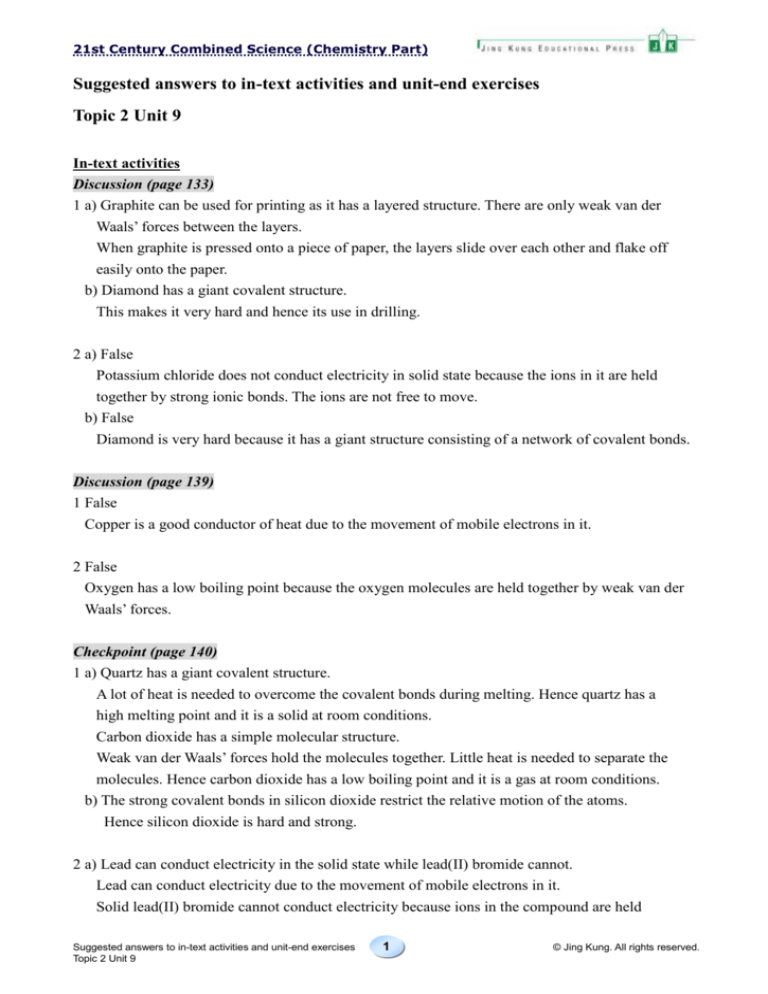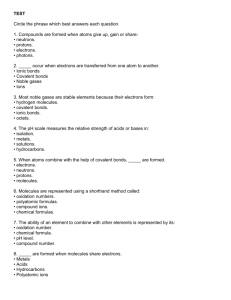
21st Century Combined Science (Chemistry Part)
Suggested answers to in-text activities and unit-end exercises
Topic 2 Unit 9
In-text activities
Discussion (page 133)
1 a) Graphite can be used for printing as it has a layered structure. There are only weak van der
Waals’ forces between the layers.
When graphite is pressed onto a piece of paper, the layers slide over each other and flake off
easily onto the paper.
b) Diamond has a giant covalent structure.
This makes it very hard and hence its use in drilling.
2 a) False
Potassium chloride does not conduct electricity in solid state because the ions in it are held
together by strong ionic bonds. The ions are not free to move.
b) False
Diamond is very hard because it has a giant structure consisting of a network of covalent bonds.
Discussion (page 139)
1 False
Copper is a good conductor of heat due to the movement of mobile electrons in it.
2 False
Oxygen has a low boiling point because the oxygen molecules are held together by weak van der
Waals’ forces.
Checkpoint (page 140)
1 a) Quartz has a giant covalent structure.
A lot of heat is needed to overcome the covalent bonds during melting. Hence quartz has a
high melting point and it is a solid at room conditions.
Carbon dioxide has a simple molecular structure.
Weak van der Waals’ forces hold the molecules together. Little heat is needed to separate the
molecules. Hence carbon dioxide has a low boiling point and it is a gas at room conditions.
b) The strong covalent bonds in silicon dioxide restrict the relative motion of the atoms.
Hence silicon dioxide is hard and strong.
2 a) Lead can conduct electricity in the solid state while lead(II) bromide cannot.
Lead can conduct electricity due to the movement of mobile electrons in it.
Solid lead(II) bromide cannot conduct electricity because ions in the compound are held
Suggested answers to in-text activities and unit-end exercises
Topic 2 Unit 9
1
© Jing Kung. All rights reserved.
21st Century Combined Science (Chemistry Part)
together by strong ionic bonds.
b) Lead(II) bromide will conduct electricity in the molten state because ions in the compound
become mobile.
3 Potassium chloride has a higher melting point.
Potassium chloride has a giant ionic structure. A lot of heat is needed to overcome the strong ionic
bonds between the ions during melting.
Hydrogen chloride has a simple molecular structure. Little heat is needed to separate the
molecules.
Checkpoint (page 145)
1 a) Ionic bond
b)
c) Giant ionic structure
d) i) Z has high melting point and boiling point.
To melt or boil it, a lot of heat is needed to overcome the strong ionic bonds between the ions.
ii) Z conducts electricity in molten state or aqueous solution because mobile ions are present.
2 a)
b) i) Silicon carbide has a giant covalent structure.
The strong covalent bonds restrict the relative motion of the atoms.
Hence silicon carbide is hard and strong.
Suggested answers to in-text activities and unit-end exercises
Topic 2 Unit 9
2
© Jing Kung. All rights reserved.
21st Century Combined Science (Chemistry Part)
ii) To melt silicon carbide, a lot of heat is needed to overcome the strong covalent bonds.
Hence silicon carbide has a high melting point.
Checkpoint (page 147)
1 a) Simple molecular structure
b) Giant metallic structure
c) Simple molecular structure
d) Giant ionic structure
e) Giant covalent structure
2 a) BF3 — covalent bond
AlF3 — ionic bond
b)
BF3
AlF3
3 a) Sulphur dioxide.
Sulphur dioxide is a solid at –75 °C. It melts at –75 °C but only boils at –10 °C. Hence it is a
liquid at –50 °C.
b) Van der Waals’ forces
STSE Connections (page 148)
1 • Light
• Strong
• Excellent conductor of electricity
• Corrosion resistant
• Ductile
2 Advantages:
• Aluminium is lighter and thus easier to transport.
• Aluminium is more corrosion resistant.
• Aluminium can be dyed more easily.
Suggested answers to in-text activities and unit-end exercises
Topic 2 Unit 9
3
any one
© Jing Kung. All rights reserved.
21st Century Combined Science (Chemistry Part)
Disadvantages:
• Aluminium is more expensive.
• Aluminium is not so strong.
any one
Unit-end exercises (pages 153-161)
Answers for the HKCEE and HKALE questions are not provided.
1
2
Giant ionic
structure
Giant covalent
structure
Simple molecular
structure
Giant metallic
structure
potassium chloride
calcium carbonate
quartz
diamond
water
sugar
tetrachloromethane
oxygen
aluminium
potassium
3
Type of forces of attraction
Sodium particles in sodium metal
metallic bonds
Particles in table salt
ionic bonds
Carbon and oxygen atoms in carbon dioxide molecules
covalent bonds
Carbon dioxide molecules in dry ice
van der Waals’ forces
Iodine molecules in iodine crystal
van der Waals’ forces
Silicon and oxygen atoms in quartz
covalent bonds
Suggested answers to in-text activities and unit-end exercises
Topic 2 Unit 9
4
© Jing Kung. All rights reserved.
21st Century Combined Science (Chemistry Part)
4 a) Gold
b) Potassium bromide
c) Diamond.
Diamond consists of a network of covalent bonds. Relative motion of the atoms is restricted.
5B
6C
7A
X (fluorine) is a non-metal while Y (magnesium) is a metal. They react to form an ionic
compound.
Z (sulphur) in the molten state contains mobile molecules. It cannot conduct electricity.
8B
9C
10 A
11 A
(2) The structure of silicon is similar to that of diamond.
(3) Ionic bond exists between ions in potassium chloride.
12 B
13 —
14 —
15 —
16 a) Carbon dioxide has a simple molecular structure.
Weak van der Waals’ forces hold the molecules together. Little heat is needed to separate the
molecules. Hence carbon dioxide has a low boiling point and it is a gas at room conditions.
Silicon dioxide has a giant covalent structure.
A lot of heat is needed to overcome these bonds during melting. Hence silicon dioxide has a
high melting point and it is a solid at room conditions.
Suggested answers to in-text activities and unit-end exercises
Topic 2 Unit 9
5
© Jing Kung. All rights reserved.
21st Century Combined Science (Chemistry Part)
b) i)
ii) Silicon has a high melting point.
In silicon, each atom is covalently bonded to four other atoms in a giant structure.
A lot of heat is needed to overcome these bonds during melting.
c)
17 a) i) Sodium chloride is made up of sodium ions and chloride ions arranged in a cubic pattern.
In the lattice, each sodium ion is surrounded by 6 chloride ions and each chloride ion is
surrounded by 6 sodium ions.
ii) In graphite, the carbon atoms are arranged in flat parallel layers.
Within each layer, each carbon atom is covalently bonded to three other atoms, forming a
hexagonal arrangement.
There are weak van der Waals’ forces between the adjacent layers.
b) Graphite has a layered structure. The layers are held by weak van der Waals’ forces.
When graphite is pressed onto a piece of paper, the layers slide over each other and flake off
easily onto the paper.
c) i) Molten sodium chloride conducts electricity due to the presence of mobile ions in molten
sodium chloride.
ii) In solid graphite, each carbon atom has four outermost shell electrons. Each carbon atom
uses three electrons in forming covalent bonds.
The remaining electron is delocalized between the layers of carbon atoms. Graphite
conducts electricity due to the presence of delocalized electrons.
Suggested answers to in-text activities and unit-end exercises
Topic 2 Unit 9
6
© Jing Kung. All rights reserved.
21st Century Combined Science (Chemistry Part)
18 a) A — sodium chloride
b) i) Ionic bonding
B — diamond
C — iodine
ii) Covalent bonding
c) Solid A has a higher melting point.
A lot of heat is needed to overcome the strong ionic bonds between the ions in A.
On the other hand, weak van der Waals’ forces exist between the molecules in solid C.
Little heat is needed to separate the molecules.
d) A can conduct electricity in molten state or aqueous solution as ions in A become mobile in
molten state or aqueous solution.
19 a)
b) In silica, covalent bonds hold all the outermost shell electrons of the atoms firmly together.
There are no mobile electrons or ions. Hence it does not conduct electricity.
20 a) The outermost shell electrons of each metallic atom are free to move randomly in a piece of
metal.
Hence a piece of metal consists of positively charged ions surrounded by a ‘sea’ of electrons.
b) Copper is a good conductor of electricity due to the movement of mobile electrons.
When a piece of copper is connected to a battery, mobile electrons in the metal flow towards
the positive terminal of the battery.
At the same time, electrons flow into the other end of the metal from the negative terminal of
the battery.
c) Ions in copper are packed in layers.
When we apply a force to a piece of copper, the layers slide through the ‘sea’ of electrons to
new positions.
The metal does not break because the ions are still bound together by the ‘sea’ of electrons. As
a result, copper can be drawn into wires.
Suggested answers to in-text activities and unit-end exercises
Topic 2 Unit 9
7
© Jing Kung. All rights reserved.
21st Century Combined Science (Chemistry Part)
21 a) E
It can only conduct electricity in molten state but not in solid state.
b) B, C
B has a very low melting point and it does not conduct electricity.
C does not conduct electricity and it has a low melting point.
c) D
It can conduct electricity in both solid and molten states.
d) A
It has a very high melting point and it does not conduct electricity.
22 a) i) f
ii) g
b) Noble gases
c) b
d) i) Compound formed between elements b
(carbon) and h (sulphur).
Compound formed between elements f
(sodium) and h (sulphur).
ii) The forces between particles in the compound formed between b and h are weak van der
Waals’ forces.
The forces between particles in the compound formed between f and h are strong ionic
bonds.
Particles in the first compound separate easily. Hence the compound formed between b and
h is more volatile.
23 Sodium chloride is made up of sodium ions and chloride ions arranged in a regular pattern.
Sodium chloride has a high melting point because a lot of heat is needed to overcome the ionic
bonds between the ions during melting.
Molten sodium chloride conducts electricity due to the presence of mobile ions.
In graphite, the carbon atoms are arranged in flat parallel layers. Within each layer, each carbon
atom is covalently bonded to three other atoms. The remaining electron is delocalized between
the layers of carbon atoms.
Graphite has a very high melting point because a lot of heat is needed to overcome the strong
covalent bonds between the atoms.
Graphite conducts electricity due to the presence of delocalized electrons.
Magnesium consists of positively charged ions surrounded by a ‘sea’ of mobile electrons.
Magnesium has a high melting point as well. This is because a lot of heat is needed to overcome
Suggested answers to in-text activities and unit-end exercises
Topic 2 Unit 9
8
© Jing Kung. All rights reserved.
21st Century Combined Science (Chemistry Part)
the strong metallic bonds holding the ions in magnesium together.
Magnesium conducts electricity due to the presence of mobile electrons.
24 —
Suggested answers to in-text activities and unit-end exercises
Topic 2 Unit 9
9
© Jing Kung. All rights reserved.









